
Related
Guests
- Rebecca Petersinternational arms control advocate who led the campaign to reform Australia’s gun laws after the Port Arthur massacre. She also produced the landmark report, “Gun Control in the United States: A Comparative Survey of State Firearm Laws,” with the Open Society Institute in New York.
In the wake of the Newtown killings that left 27 people dead on Friday, we go to another New Town — in Australia — the home of a mass shooting that killed 35 people in 1996. Just 12 days after what became known as the Port Arthur massacre, Australia’s government responded by announcing a bipartisan deal to enact gun control measures. There have been no mass killings since. We’re joined by Rebecca Peters, an international arms control advocate who led the campaign to reform Australia’s gun laws after the Port Arthur massacre. She also produced the landmark report, “Gun Control in the United States: A Comparative Survey of State Firearm Laws,” with the Open Society Institute in New York. [includes rush transcript]
Transcript
AMY GOODMAN: Well, as the debate over gun control is revived in the wake of the Sandy Hook shootings, we turn now from Newtown, Connecticut, to New Town, Australia, where gun laws were immediately revised following the worst mass murder in the country’s history. On April 28th, 1996, a gunman from New Town, Australia, opened fire on tourists in Port Arthur, Tasmania, killing 35 people and wounded 23 more. This is an Australian television report on the incident from the day of the shooting.
STEVE CAREY: Helicopters began ferrying the injured to Hobart from Port Arthur after a gunman opened fire there this afternoon.
GEOFF EASTON: We’ve had a gunman run amok on the Port Arthur historic site. That’s 85 Ks from Hobart. Happened mid-afternoon. There are least 12 confirmed dead, if not 22. There’s a further 15 injured. At the moment, we have a hostage situation, which we’re attempting to contain and control.
STEVE CAREY: The convict ruins are a favorite with interstate and overseas tourists. It’s understood those visitors have made up the bulk of those killed or wounded. Locals near the site cringed in fear inside their shops and homes as the gunman opened fire.
PORT ARTHUR STOREKEEPER: Everyone’s just freaking.
STEVE CAREY: What do you understand he may have done?
PORT ARTHUR STOREKEEPER: Killed lots of people.
STEVE CAREY: Any idea why?
PORT ARTHUR STOREKEEPER: No. No idea.
STEVE CAREY: Any idea who he was?
PORT ARTHUR STOREKEEPER: No, no idea. Not a local, I don’t think.
STEVE CAREY: Do you know if any tourists have been involved?
PORT ARTHUR STOREKEEPER: Yes, they have been.
STEVE CAREY: It just sounds awful.
PORT ARTHUR STOREKEEPER: It is awful. It’s very, very awful.
AMY GOODMAN: The death toll eventually rose to 35 in what came to be known as the Port Arthur massacre. The person who carried out the mass killing was Martin Bryant, ironically from a place called New Town.
Well, just 12 days after the grisly attack and the public outcry it launched, Australia’s government responded by announcing a bipartisan deal to enact gun control measures. The pact included agreements with state and local governments. Since the laws were passed—for more than 15 years—there has not been a mass shooting in Australia.
After break, we’ll be joined by the woman who led the campaign to reform Australia’s gun laws after the Port Arthur massacre. This is Democracy Now! We’ll be back with her in a moment.
[break]
AMY GOODMAN: In the wake of the Newtown killings that killed 20 children on Friday and six staff at the school, as well as the mother of the shooter, we go to another New Town: New Town, Australia, the home of an Australian man who killed 35 people in 1996. Just 12 days after what became known as the Port Arthur massacre, Australia’s government responded by announcing a bipartisan deal to enact gun control measures—this in a country of hunters and gun lovers. The pact included agreements with state and local governments. Since the laws were passed—for more than 15 years—there’s not been a mass shooting in Australia.
In a moment, we’ll be joined by the woman who led the campaign to reform Australia’s gun laws after the massacre, but first I want to play a clip from 1996 of a man who survived the Port Arthur massacre and described what he saw. This is Peter Crosswell speaking from his hospital bed shortly after the attack.
PETER CROSSWELL: I looked up from the table more towards the front door of the restaurant, and as I did, this guy walked in—long blond hair—and shot dead one guy that was sitting at the nearest table. He then proceeded to shoot everybody at that table. At that time, I jumped on top of the two women that I was with and landed on the floor, and I told them just to lay dead still. I can see the feet of the guy who had walked into the room with the gun. And he just proceeded to shoot everybody in the room. He walked—walked through the room past us into the—into the souvenir area, where I heard more gunshots. And then he came back and shot at myself and the two ladies—and thankfully missed. That time, he must have seen somebody that’s still alive and walked towards that person. He yelled out, “No, no!” He then shot him. Another person who was also moving nearby was screaming, and he just walked up and shot her. He then walked back past us, and I thought he was going to kill us, but instead he walked to the door, hesitated for about 15 minutes and then—oh, sorry, 15 seconds, perhaps, and reloaded his gun and went outside.
AMY GOODMAN: A victim of the Port Arthur massacre. The shooter, Martin Bryant, from New Town, Australia. His gun was a Colt AR-15 rifle, a semi-automatic weapon. The weapon used by the shooter in Newtown, Connecticut, by Adam Lanza, was also an AR-15. It was a Bushmaster.
Joining us now is Rebecca Peters, who was chairperson of Australia’s National Coalition for Gun Control at the time of the 1996 Port Arthur massacre. She later became director of the International Action Network on Small Arms, was also a senior fellow at the Open Society in New York, where she produced a landmark report, “Gun Control in the United States: A Survey of State Firearm Laws.” Rebecca Peters is joining us today from San Francisco.
Rebecca, welcome to Democracy Now!
REBECCA PETERS: Thank you, Amy.
AMY GOODMAN: From New Town to Newtown, what a horrific story. But the similarities in the countries—a country of gun lovers in the United States, hunters and gun lovers in Australia, yet this moment shattered all of that in Australia. Explain what happened afterwards.
REBECCA PETERS: Well, it was in—Australia at the time was, as you said, a country, and it still is a country, where hunting is an important activity. There is a—Australia wins Olympic medals in shooting. You know, in Australia there’s a high premium placed on rugged masculinity, and it’s a frontier country. And so, it has some similarities with the U.S.
And also, another similarity was that we had had, in the previous couple of decades, occasionally mass shootings. About once a year, we had a mass shooting. And on each occasion, there was a lot of talk about the gun laws and politicians, similar to here, actually, avoiding the issue, saying, “Well, we need to look at family values and mental health and everything else,” and basically being too frightened to do anything about the gun laws, because the gun lobby always threatened to punish electorally any party that did actually strengthen the laws.
What happened in '96 was so shocking, and also the level of anger and dissatisfaction and frustration in the public was so high by then, that really that was the tipping point for Australia. As you said, the prime minister exercised leadership. He called all the states together and said, “We're going to fix this.” And the laws were state laws, so we had a patchwork of different laws. Some states had stronger laws, but the states that had weaker laws undermined those with stronger laws. And what we got was a scheme of nationally uniform laws, which set a much higher standard and included bans on assault weapons and some other measures, which basically meant that the whole—that you can still own guns in Australia, but the system is just much more under control.
And as a result, now 15 years later, we’ve not had a mass shooting since that time, and also gun deaths in general are about 50 percent lower than what they were. And that—the laws—the evaluation of the law shows that about—it’s also—it’s saving hundreds of lives each year and also about $500 million a year in the economic costs of violence that’s been avoided. So, overall, our gun laws are a resounding success.
AMY GOODMAN: I wanted to play a clip of Dianne Feinstein, the California senator, represents the state you happen to be in right now. She was the author of the 1994 Assault Weapons Ban, and she announced she’s going to introduce a bill to reform gun ownership standards in the next Congress, on the first day.
SEN. DIANNE FEINSTEIN: I’m going to introduce in the Senate, and the same bill will be introduced in the House, a bill to ban assault weapons. It will ban the sale, the transfer, the importation and the possession, not retroactively, but prospectively. And it will ban the same for big clips, drums or strips of more than 10 bullets. So there will be a bill. We’ve been working on it now for a year. We’ve tried to take my bill from ’94 to 2004 and perfect it. We believe we have. We exempt over 900 specific weapons that will not be—fall under the bill.
AMY GOODMAN: There is Senator Dianne Feinstein. There is a moment in this country right now, I mean, that we have never seen anything like it. You have the NRA website—the Facebook page has gone dark. Senator after senator—I mean, Senator Manchin of West Virginia, his—one of his TV ads was holding a weapon—saying they are considering everything now. You have talk show hosts like Joe Scarborough on MSNBC saying he had a number one top rating of the NRA, and he said our politicians cannot protect the status quo anymore but must protect our children. It is an astounding moment right now. But you have Dianne Feinstein then saying there will be 900 exceptions. What do you think—do you think—since you have looked at our laws in the United States, as well, new thinking could bring? And the fact that the politicians and the NRA have gone silent, at least publicly, is—are people thinking in a new way? Are they going to move forward or simply get what they think they could conceivably get, perhaps the day before Sandy Hook?
REBECCA PETERS: Well, it does seem to be a different—something does seem to have changed in the U.S. I hope something has changed. And it should be—and I suppose what people all over the world are asking is, if the U.S. can’t do something about guns now, when a tragedy like this has occurred, you know, it’s difficult to imagine in what circumstances it could.
The ban on assault weapons is one of the most important changes that’s needed in the U.S. And I haven’t seen the list of guns that are exempted, so I don’t know how that will be defined. Nine hundred does sound like a lot of weapons to exempt, so I hope that—I hope that it will be a genuine assault weapons ban.
But the other thing that is—the other really fundamental problem in the U.S. gun laws, one is that, of course, that the laws are different in different states, so that it’s possible to—for the weak states to undermine the strong ones.
But also, there’s—I think perhaps a lot of Americans are not aware that there isn’t a background check conducted not everyone who buys a gun. So, if you buy a new gun in the U.S. in a gun shop, then you have to undergo a criminal background check. But if you buy a secondhand gun in—at a gun show or from a garage sale or from a private individual, then you don’t have to undergo a background check in most states. And it’s estimated that about 40 percent of gun sales are actually in formal secondhand sales. And so, that’s an open invitation for criminals to buy guns without a background check. So that’s also an important step forward—would be—to say every gun, every gun purchase, has to be subject to a background check. It makes—there’s no—it just makes no sense at all to say that there’s no difference between the lethal power of a secondhand or a new gun.
And the other thing is that the quality of background checks, the records that are available, the systems for checking are very poor, and it’s a patchwork across the country. So there needs to be a high standard of information available to authorities. I mean, ideally there would be other measures, too. But the most—the most fundamental measures that should be taken are a ban on assault weapons and a higher standard and a uniform standard of background checks on all gun sales.
AMY GOODMAN: I was just talking to Congressmember Carolyn McCarthy, you know, from Long Island, who lost her own husband in the Long Island Rail Road massacre, and her son was severely wounded in that shooting. And she was saying, you know, the terrorist watch list—politicians, pro-gun senators and congressmembers and the NRA have prevented even legislation that would allow the kind of background check that would check against a terrorist watch list.
Now, interestingly, just this morning, private equity firm Cerberus has put U.S. firearms maker Freedom Group up for sale, following Friday’s killing. Freedom Group includes Bushmaster, maker of the rifle used in the shooting at the school in Newtown.
I wanted to turn to Paul Barrett, who we had on yesterday, assistant managing editor at Bloomberg Businessweek, author of Glock: The Rise of America’s Gun, another of the guns that Adam Lanza had, the shooter in Connecticut. I asked him about Senator Feinstein’s announcement that she’ll reintroduce the ban on assault weapons on the first day of the Senate. This was his response.
PAUL BARRETT: I’ll read the legislation very closely when it’s actually out. I have to say I’m skeptical. I mean, the 1994 so-called Assault Weapons Ban was one of the most porous, ineffective pieces of legislation that I personally have ever had the opportunity to study. It was shot through with loopholes. It had no applicability to weapons that were made and sold on the day before enactment. And the fact that it was coming for a period of years gave gun manufacturers an opportunity to run their factories overtime and to build up huge stockpiles of the weapons. So we’ll see. But if Congress is not proposing to ban weapons that are already out there, then that leaves millions and millions of weapons already out there.
AMY GOODMAN: That’s Paul Barrett, author of the book Glock: The Rise of America’s Gun. Rebecca Peters, your response, and if you could compare it to the legislation that was passed in Australia after the massacre and also talk about the buyback aspect of that legislation?
REBECCA PETERS: Yeah. Well, so, in Australia, the new law banned semi-automatic rifles and shotguns, assault weapons, and we did ban not only new sales, it was a—we banned importation sales, and we also banned ownership, so currently owned weapons were prohibited. And the government bought those guns back at a rate of about the retail price plus about 10 percent. And in addition, you couldn’t get them repaired. You couldn’t—you couldn’t sell them. You sort of—I mean, it was a very comprehensive ban.
And as a—and the buyback ended up buying back and destroying more than about 650,000 of these weapons, which is the largest buyback and destruction program for guns anywhere in the world still now. It’s bigger than post-conflict buybacks, for example, in African countries. And, you know, it was interesting, the gun owners had—many gun owners were not happy to have to hand in their guns, but they were happy to be paid for them. And if they were—if they qualified to own guns under the legislation, because it also raised the standard of how you qualified for a license, if they could—they could buy another gun that wasn’t an assault weapon.
But the—of course, we did constant polling and surveys. And what it showed was that gun owners recognized that—I mean, these were not—most people who owned these guns were not criminals. They had bought them because they were available and because they were promoted and marketed by the gun industry. But they recognized that these guns were not suitable for civilian ownership in a country not at war, that they’re not sporting weapons. It was—there was a—there’s an organization in Australia called the Professional Shooters’ Association, which is like the—you know, the original Crocodile Dundee, these more-macho-than-macho guys who go and shoot feral animals in the wildest parts of Australia, you know, on contract for the National Park Service. And these guys said, “If you need a semi-automatic to kill an animal, then you’re a city boy who shouldn’t be out here in the first place.” You know, our Olympic shooting team won gold at the Atlanta Olympics in that year. And they also said, “Look, there’s just—these weapons, there’s just an excessive amount of firepower that being available,” and they recognized that it was—that it was—that things had gone too far and that it was a good idea to rein it in. They handed in their weapons, got the compensation. And in general, there was a high degree of cooperation and of support for the laws. And we’ve seen the results, in terms of a much higher standard of community safety.
AMY GOODMAN: Rebecca Peters, what about the effect on suicide? We’re talking about 30,000 gun deaths a year, and the majority of them are people who have access to guns who pull the trigger—
REBECCA PETERS: Yeah.
AMY GOODMAN: —on themselves.
REBECCA PETERS: Yeah. And, well, it’s—that’s been interesting also. In Australia, most gun deaths are suicides. In America, most gun deaths are suicides, as well. And the effect on—the reduction in gun deaths has been seen both in homicides and in suicides in Australia. And it also affects—it’s not just about legislation. It’s also about culture. It’s also about awareness. And in addition to changes in the law, a lot of changes in behavior have occurred, because law does affect behavior. So we also have much higher standards of safety, you know, and the law is—in Australia, the laws recognize the nature of violence in our society. So, for example, someone who is—lives in a house with someone who is suicidal, during the—if the person who wants to buy a gun, during the course of inquiries about whether this is a suitable—whether the license should be approved, if it comes to the notice of the police that there’s another person in the house who has a serious mental illness, who is at risk of suicide, then that is something to take into account in terms of deciding whether there should be a gun license issued to anyone in that house, just recognizing that access to guns is a risk for everyone in the house. And so, I know, for example, people who have had as a condition of their license that they have to store the gun somewhere else, so that the guns are not available to someone else in the house who has a serious mental health problem and is at risk to themselves or others. So, it’s possible to have a system which takes into account all the circumstances of each case. And we’ve seen the benefit in terms of reductions in suicide as well as homicide.
The thing about guns is, there’s no second chance, usually. You know, when you look at the statistics on attempted suicide and on assault, compared with completed suicide and homicide, firearms are the most lethal method. And if you can reduce access to firearms, then it’s—then even if people are depressed, angry, drunk, jealous, for whatever reasons people engage in violent behavior toward themselves or others, the absence of a firearm makes it more likely that the—that there will—that the person will survive that attempt.
AMY GOODMAN: Well, I mean, we saw it in China just hours before the Sandy Hook massacre at the elementary school. A man in China went into a school, knifed 23 people, 22 of them children. But almost all of them, but one, survived because it was a knife and not a gun.
REBECCA PETERS: Yeah, yeah, because the thing is that—and, I mean, it seems obvious, but maybe it’s worth saying, that a gun is a particularly lethal method of damaging human bodies, not only because the bullets move at high speed, and they’re frequently designed specifically to damage human bodies, but also because the—in an attack with a gun, a person running away can still be shot. In an attack with a gun also means that people in the—other people are less likely to intervene. I mean, there are a lot of reasons why an attack with a gun is more lethal than an attack with a knife. And that is why, specifically, strong rules are justified to have on a weapon that is specifically made for killing.
AMY GOODMAN: Rebecca, we only have a few minutes, and I have a bunch of questions. One, how would this affect concealed carry? I think of the professors at the University of Colorado, Boulder, pleading with the—around the new law that says students can carry on—concealed weapons onto campus, saying they’re terrified of giving a student a bad grade. I also want to know—you have looked at other countries, outside of Australia, the kind of laws that they have. And how powerful, in Australia, was the gun lobby? I mean, look at the NRA. They’re hiding their heads right now. Their Facebook page is down. But, you know, this is a particular moment, when the legislation is actually debated.
REBECCA PETERS: Yeah.
AMY GOODMAN: We’ll see what happens.
REBECCA PETERS: Yes. Well, we did have—I mean, the gun lobby was very powerful in Australia at the time. But the combination of public opinion and also the political situation at the time—quite important, the prime minister in Australia had just won the election, and so he had some political space, which made it possible for him to—you know, to take a bold step. And in that sense, President Obama—
AMY GOODMAN: Very similar to President Obama.
REBECCA PETERS: Exactly. He’s just been re-elected. It gives him some leeway there.
In terms of other countries, in general, the move across the world is toward stronger gun laws, as—and also it is toward greater uniformity, so cooperation between countries, but also within countries. In federal systems like the U.S. and Australia, it’s increasingly recognized that guns travel across borders. It doesn’t—and that people travel across borders, and that it doesn’t—why should people be safer in one—you know, why should people in one state be entitled to a level of safety more than people in another state? That just doesn’t make sense. So the trend across the world is toward tighter regulation. And, of course, the U.S. is the largest producer and exporter of guns in the world. So what happens in the U.S. in terms of regulation actually has a potential impact for the rest of the world, as well.
AMY GOODMAN: Rebecca Peters, I want to thank you very much for being with us. She previously led the campaign to reform Australia’s gun laws in her capacity as chair of the National Coalition for Gun Control, former director of the International Action Network on Small Arms, was senior fellow of the Open Society Institute here in New York, where she produced a landmark report, which we will link to, “Gun Control in the United States: A Comparative Survey of State Firearm Laws.” Go to democracynow.org. When we come back from our break, we turn to Michael Moore, speaking a few hours after the massacre in Connecticut. Stay with us.

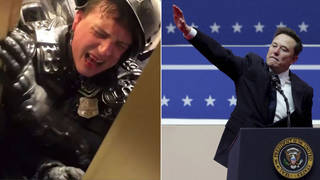
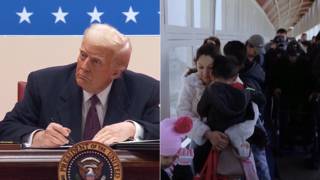
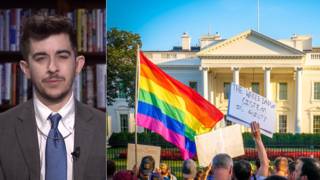
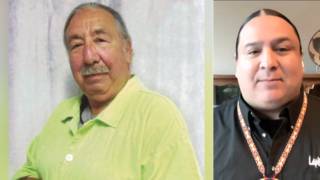
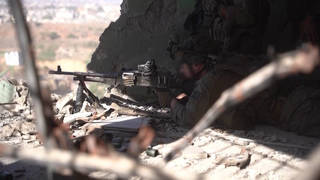




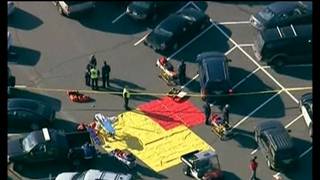

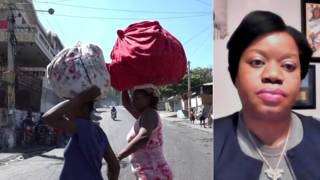
Media Options